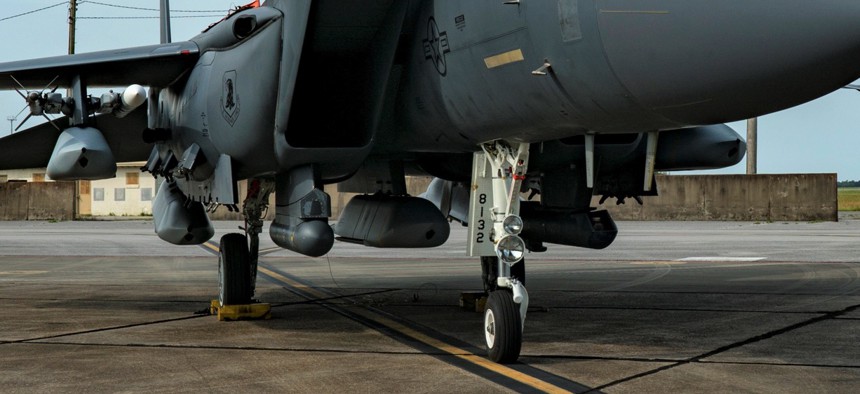
An F-15E Strike Eagle is loaded with five JASSM missiles at Eglin Air Force Base, Fla., May 11, 2021. Air Force / Master Sgt. Tristan McIntire
We Don't Have the Missiles to Stop China. Time For Drone Swarms
Despite all the calls to boost production, the U.S. military will be short of key missiles for at least two years. It needs ways to win with what it has now.
The war in Ukraine made plain several well-known challenges with precision weapons: they are expensive, rely on complicated supply chains, and take time to build. With Russia’s invasion stretching into its second year and military leaders warning of a looming war with China, analysts, Congress, and defense officials are all arguing for dramatically increased spending on the sophisticated long-range missiles needed for war in the Indo-Pacific.
This is a failure of both analysis and imagination by the world’s largest and most expensive defense establishment.
Decades of funding and policy decisions have led to a “right-sized” defense industry that can produce precision-guided missiles only at a peacetime replacement rate. Efforts to accumulate more PGMs could draw on the excellent recommendations made by recent studies: multi-year purchases, better management of existing stocks, and, yes, increased spending. Yet the fundamental limits remain: rocket fuel, explosives, microelectronics, and skilled technicians are all in short supply. Ramping up production of key missiles, therefore, will take two years or more.
That is time the U.S. military may not have. If Chinese leaders decide military action is necessary to achieve their goals of Indo-Pacific hegemony and a subjugated Taiwan, they are unlikely to wait for the Pentagon to rebuild its weapons stockpiles, field new B-21 bombers, and establish widespread firebases throughout southwest Japan and the Philippines. An invasion of Taiwan may not be imminent, but China’s President Xi may perceive a window opening during which he can change the status quo through a range of operations from blockades or quarantines to cyber attacks, island occupations, and bombardment.
The defense establishment must not pretend that simply opening the money spigots will provide the missiles that will enable the U.S. military to fight the way it wants to against the People’s Liberation Army. Instead, U.S. forces must adopt new concepts and tactics that can win with the weapons and systems they can field this year and next.
The war in Ukraine, recent operations by Iran, and the war in Nagorno-Karabakh offer some ideas. Faced with shortages in sophisticated PGMs due to sanctions or attrition, combatants in each of these conflicts turned to unmanned systems that help fill the gaps in some innovative ways.
As Russia ran short of many of its best long-range weapons, it began to mount large-scale strikes on Ukrainian infrastructure that combined cheap and numerous drones with cutting-edge Kinzhal hypersonic missiles. By overwhelming Ukrainian air defenses with drones, Russian attackers hoped to improve the missiles’ survivability and allow a smaller salvo to be more destructive.
Don't miss:
A similar approach has been used by Iran and its Houthi proxies. Constrained by sanctions to building simple missiles and drones, they have nevertheless mounted strikes during the last half-decade in Iraq, Saudi Arabia, and the Persian Gulf.
The U.S. military is coming around to the idea of using uncrewed vehicles to protect and enhance smaller long-range missile salvos. Programs like the Air Force’s Skyborg and Army’s Air-Launched Effects are intended in part to build drones that can jam or confuse air defenses or precisely guide missiles to where they can do the most damage.
Although they receive less attention and funding than the PGMs they support, systems such as Air-Launched Effects and Skyborg could represent the fastest route to a more lethal U.S. force. By making each missile more accurate and survivable, these uncrewed vehicles could help stretch strained U.S. and allied magazines. Based on existing or modified vehicles, they could be fielded at scale in the time it takes a new missile production line to come on service.
Or U.S. forces can forgo the missiles entirely. Over the last two years, Ukraine, Russia, Israel, and Iran have all used long-endurance drones to strike enemy bases, infrastructure, and ships. Using everything from DJI quadcopters with hand grenades to Shahed-136 suicide drones carrying 200 pounds of explosives, these militaries have circumvented opponents’ air defenses through a mixture of slow speed, low radar signature, and numbers.
New technologies made these new tactics possible. Commercial automation software and microelectronics from the telecommunications, automobile, and shipping industries contribute. But more important is the emergence of commercial mission-planning and command-and-control software that can orchestrate drone and missile operations to avoid defenses, locate concealed targets, and maximize impact on the enemy.
An added benefit of commercially-derived hardware and software is in mobilization. The inability of the U.S. defense industrial base to surge production for wartime has been analyzed, described, and bemoaned during the last decade. But by shifting more of its force design toward commercially-derived technologies, the U.S. military could create the potential for commercial mobilization on a scale not seen since World War II.
With a narrowing window to field a force that can thwart Chinese aggression in the Western Pacific, the Pentagon cannot afford to wait for the defense industry, evolved for peacetime efficiency, to build a military that can fight like defense planners want to fight. Instead, the DoD needs to reimagine how it can fight using the military it can get. Our adversaries and allies are showing a path to success. The Pentagon, and its supporters in Congress, need to start running toward it.
Bryan Clark is a Director of the Hudson Institute Center for Defense Concepts and Technology.

